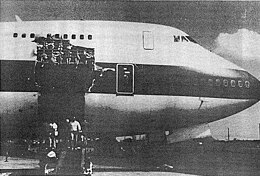United Airlines Flight 811
United Airlines Flight 811 was a scheduled flight from Los Angeles, United States to Sydney, Australia, with stops at Honolulu, Hawaii and Auckland, New Zealand. On February 24, 1989, the Boeing 747-122 (registered N4713U) operating the route suffered a failure in a cargo door. This caused an explosive decompression. This resulted in nine passengers dying.
 N4713U after the cargo door tore off in flight, causing an explosive decompression and ejecting nine people from the plane | |
| Accident | |
|---|---|
| Date | February 24, 1989 |
| Summary | Cargo door failure due to design flaw leading to explosive decompression[1] |
| Site | Pacific Ocean near Honolulu, Hawaii 20°41′24″N 158°40′30″W / 20.690°N 158.675°W |
| Aircraft | |
| Aircraft type | Boeing 747-122 |
| Operator | United Airlines |
| IATA flight No. | UA811 |
| ICAO flight No. | UAL811 |
| Call sign | UNITED 811 |
| Registration | N4713U (re-registered N4724U after repairs) |
| Flight origin | Los Angeles International Airport, Los Angeles, California, U.S. |
| 1st stopover | Honolulu International Airport Honolulu, Hawaii, U.S. |
| 2nd stopover | Auckland Airport Auckland, New Zealand |
| Destination | Sydney Airport Sydney, Australia |
| Occupants | 355 |
| Passengers | 337 |
| Crew | 18 |
| Fatalities | 9 |
| Injuries | 38 |
| Survivors | 346 |
Aircraft
changeThe incident aircraft, N4713U, was a Boeing 747 which flew for United Airlines. [2] The aircraft was given to United Airlines in November 1970.[3]
Flight
changeBefore the incident, the aircraft flew from Los Angeles, United States to Honolulu, United States.[2]
It took off from Honolulu at 01:52 local time, with 337 passengers on board.[1]: 1–2
Seventeen minutes after departure, as the aircraft was flying through 22,000 to 23,000 feet (6,700 to 7,000 m), the flight crew heard a loud thump.[1]: 2 About a second and a half after the thump, a cargo door opened and opened the fuselage. The resulting pressures caused 10 seats to fly off the aircraft.[1]: 8 [4] All eight passengers in those seats were killed, and another in a seat close to the incident area.[1]: 109 [4]
The pilots first thought a bomb had exploded inside the aircraft. The incident happened two months after Pan Am Flight 103 was blown up over Scotland. They began to fly down in an emergency descent. The aircraft also turned towards Honolulu.[1]: 2
Debris from the aircraft during the explosive decompression damaged engines number 3 and 4.[1]: 4–8 Engine number 3 was vibrating fast, so the pilots turned the engine off. Engine number 4 failed and was producing flames, so they turned that engine off.[1]: 2
As the aircraft was beginning to land, the pilots moved the flaps and landing gear out. However, the flaps could only be moved out a certain distance because of damaged caused by debris.[1]: 3 The aircraft landed and stopped on the runway.[4] All passengers and crew left the aircraft in less than 45 seconds.[1]: 108–109
No victims of the incident were found.[1]: 4 Pieces of clothing and body parts were found in the number 3 engine.At least one victim went into the engine.[5]
References
change- ↑ 1.00 1.01 1.02 1.03 1.04 1.05 1.06 1.07 1.08 1.09 1.10 "Aircraft Accident Report, Explosive Decompression—Loss of Cargo Door in Flight, United Airlines Flight 811, Boeing 747-122, N4713U, Honolulu, Hawaii, February 24, 1989" (PDF). National Transportation Safety Board. March 18, 1992. Retrieved January 14, 2016.
- ↑ 2.0 2.1 Ranter, Harro (February 24, 1989). "ASN Aircraft accident Boeing 747-122 N4713U Hawaii". Aviation Safety Network >. Retrieved August 16, 2017.
- ↑ "Air Dabia C5-FBS (Boeing 747 – MSN 19875) (Ex N4713U N4724U ) | Airfleets aviation". www.airfleets.net. Retrieved January 14, 2019.
- ↑ 4.0 4.1 4.2 "Unlocking Disaster". Mayday. Season 1. Episode 1. 2003. Discovery Channel Canada / National Geographic Channel.
- ↑ "Nine Sucked Out of Jet 27 Others Hurt As Side of Jumbo Craft Rips Open". The Washington Post. February 25, 1989. Archived from the original on March 3, 2018. Retrieved March 3, 2018.